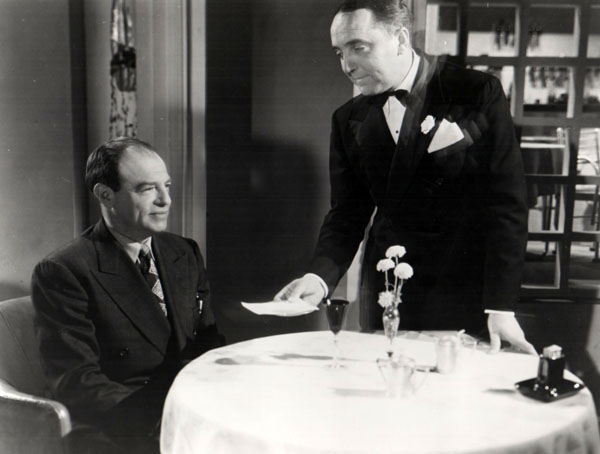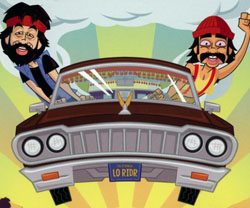
In this rare publicity still, Dave Fleischer (left) is served the check at the conclusion of TROCADERO (1944)
Dave Fleischer On Screen. In the low budget Republic live action movie Trocadero (1944), actor Eddie Bartell introduces several minor celebrities in the audience at that famous nightclub including “The world famous cartoonist Dave Fleischer” who as we all know “Dave Fleischer drew ‘Gulliver’s Travels’.”
This appearance took place between Fleischer working at Columbia’s Screen Gems and then going over to Universal.
Yes, Dave Fleischer who had been removed from his own studio almost two years earlier, sits at a table and is harassed by double-talking comedian Cliff Nazarro who gets his comeuppance when Fleischer draws a little cartoon character named “Snippy” (looking a lot like a mischievous young boy in a KoKo the Clown costume) who uses a seltzer bottle to exact revenge on the talkative dullard.
Animation historian Jerry Beck shared this anecdote with me back in 2006 and also pointed out, based on Keith Scott’s research, that Nazarro (who I had never heard of before) did voices for some Warner Brothers cartoons including Believe It Or Else (as Ripley), Slap Happy Pappy (as Eddie Cantor) and Porky’s Preview (as Al Jolson) as well as supplying the voice for Egghead in a couple of cartoons.
One of the reasons for Fleischer’s appearance might be because less than six months later he was an associate producer for another Republic live action low budget film That’s My Baby and even supplied a brief animation segment for it. Fleischer probably figured out that the money was just not there at Republic to do what he wanted to do and that Universal offered greater opportunities.
Gilliam and Out of the Inkwell. In the Guardian newspaper April 27, 2001, filmmaker and animator Terry Gilliam was asked about what he thought the ten best animated films of all time were. On his list he included the Max Fleischer “Out of the Inkwell” series.
 He explained to the newspaper: “I first saw this when I was a teenager and, in retrospect, it was a career leap for me. This was when I first discovered surrealism. You have a scenario in which you see an animator creating something which suddenly develops a life outside of the cartoon.
He explained to the newspaper: “I first saw this when I was a teenager and, in retrospect, it was a career leap for me. This was when I first discovered surrealism. You have a scenario in which you see an animator creating something which suddenly develops a life outside of the cartoon.
“The character starts communicating with the animator, and then it is Frankenstein all over again, the creation of a monster over which you have no control. Until I saw ‘Out of the Inkwell’ I had always thought of animation as existing on one plane, but here were the Fleischer brothers taking you right through the looking glass and into the picture.
“Of course, when I saw it, I loved it not because I wanted to be the animator whose ink comes to life, but because I wanted to be the animation, the clown wreaking havoc upon the world.”
The Lost Disney Art. Jeff Massie stated, “My dad (artist Reg Massie) was in charge of publicity for the (Disney) strike (in 1941). I recall him saying that they (the Disney artists on strike) had given away drawings of Disney characters (such as an exhausted Pluto after a day of picketing with a sign strapped to his back) as gifts for sympathy picketers (like workers at nearby Lockheed who dropped by to help picket)”. Where are all those original drawings today?
True Words. Donkey Xote (2007) is a Spanish-Italian CGI animated feature about the donkey Rucio (who looks a lot like the donkey in the film “Shrek”) who tells the “true” story about the adventures of Don Quixote. It did not do well and Lunmiq’s Carlo Alfano who distributed the film said in 2009, “The problem was the script. Average audiences won’t really appreciate the definition of a lion’s hair or the detailed texture of a forest. They want a great story.” For its later release, the film was retooled with rewritten dialogue and some plot modifications.
 Dave’s Not Here, Man. Regarding the little seen animated feature Cheech & Chong’s Animated Movie (2013) that was originally announced as “Cheech & Chong’s Smokin’ Animated Movie”, it was released theatrically to fifty plus movie theaters in the United States on April 18 and then was released on DVD and BluRay just days later on April 23.
Dave’s Not Here, Man. Regarding the little seen animated feature Cheech & Chong’s Animated Movie (2013) that was originally announced as “Cheech & Chong’s Smokin’ Animated Movie”, it was released theatrically to fifty plus movie theaters in the United States on April 18 and then was released on DVD and BluRay just days later on April 23.
The film utilized the sound tracks from the library of the top selling comedy albums produced by the duo. The animation was produced entirely at Los Angeles based Chambers Bros. Animation. New songs were written and recorded by Cheech and Chong as a money grab despite the fact that each of the comedians got paid $100,000 for the use of their likenesses, comedy sketch material and to actively promote the film.
“It’s great to be doing a movie where Cheech and I never have to get out of bed or be on camera,” stated Tommy Chong at the time.
“It’s about time that we got animated because we’ve been doing animation for years,” stated Cheech Marin. “Whether you watch it smokin’ a fattie or stone-cold sober, it’s just plain funny.”
The individual sketches were tied together by Buster the sexually transmitted body crab because the team was inspired by Scrat, the saber tooth squirrel in the Ice Age films.

Birth of Bandit. In a 1986 interview, animator Doug Wildey recalled why Jonny Quest had a bulldog as a pet: “Bandit was a cartoon dog designed by a guy named Dick Bickenbach. Prior to the designing of the dog, Joe Barbera and I had talked about a pet for Jonny and somehow a dog didn’t seem all that adventurous to me. I believe Bandit was a suggestion on the part of a toy manufacturer to get a saleable stuffed toy.
“Because I had designed a whole gang of other pets for Jonny. I had a small white cheetah and a monkey. Of course, I liked the idea of the monkey only because of the story possibilities—what a monkey could do that a dog couldn’t do realistically. I thought that would work a little better. But the dog is the thing we went with. Bickenbach did a nice job, but he was a Flintstones-type of designer.
“Somehow the dog worked, though I thought it was probably the weakest part of the show from that standpoint. I tried to keep him working as comic relief so he wouldn’t look so much like a prop thrown in. Oddly enough, if you talk to people, they will always remember the dog—what it looked like and what its name was. So it was an identifiable character and I guess you can’t argue something like that. But if a monkey or whatever had been in there, the same people would probably have remembered that pet.”


 Jim Korkis is an internationally respected animation historian who in recent years has devoted his attention to the many worlds of Disney. He was a columnist for a variety of animation magazines. With his former writing partner, John Cawley, he authored several animation related books including The Encyclopedia of Cartoon Superstars, How to Create Animation, Cartoon Confidential and Get Animated’s Animation Art Buyer’s Guide. He taught animation classes at the Disney Institute in Florida as well as instructing classes on acting and animation history for Disney Feature Animation: Florida.
Jim Korkis is an internationally respected animation historian who in recent years has devoted his attention to the many worlds of Disney. He was a columnist for a variety of animation magazines. With his former writing partner, John Cawley, he authored several animation related books including The Encyclopedia of Cartoon Superstars, How to Create Animation, Cartoon Confidential and Get Animated’s Animation Art Buyer’s Guide. He taught animation classes at the Disney Institute in Florida as well as instructing classes on acting and animation history for Disney Feature Animation: Florida.




















































Ah, yes. I remember Scott talking about Nazzaro on the “Farm Frolics” commentary on one of the Golden Collection releases. He was a freelance entertainer in demand for his mimicry, particularly those of the crooners at the time, such as Cantor. Nice obscure little piece seeing him here with Fleischer and the animated character.
I recalled that Don Messick was credited as the voice of Bandit but Hanna Barbera used a real dog’s barks and yelps for Bandit in the first run of Jonny Quest (don’t know what breed of dog that they used) later in The New Adventures of Jonny Quest and The Real Adventures of Jonny Quest (which Bandit was older) Don Messick provided Bandit’s “voice”. Now with the new cross-over Tom and Jerry/Jonny Quest DVD Tom and Jerry Spy Quest I wonder who will be doing Bandit, maybe Frank Welker or Don Messick from the VOSFX vault?
And on Donkey Xote it was known as Donkey X here in the States.
Nazzaro also did the voice of the penguin M.C. in Tex Avery’s 1938 Merrie Melody “The Penguin Parade,” doing his double-talk schtick. One of the few things he says clearly is mentioning “Leon Schlesinger and the boys.”
I bet that Monkey idea is what became Blip in Space Ghost.
In fairness, I’ve seen Nazarro in other pictures and he’s often hysterically funny. As with many comics, he can only be as good as the material he’s given.